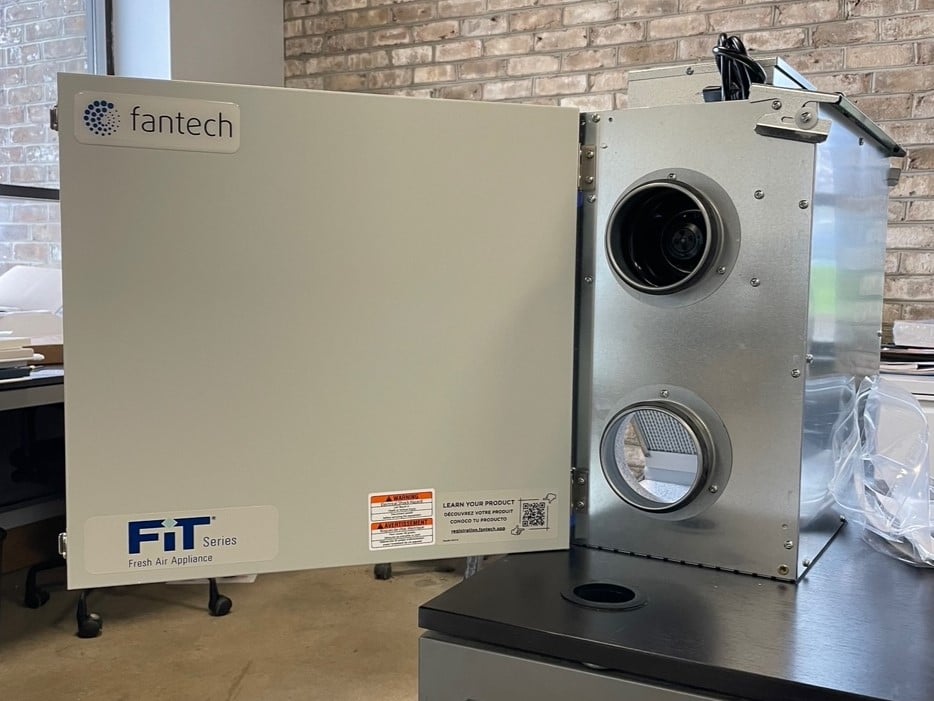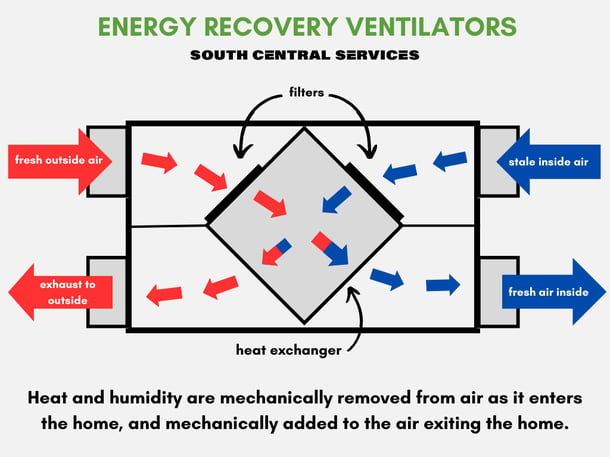
You’re looking for ways to make your home more energy efficient and heard about energy recovery ventilators. For all you know, an energy recovery ventilator is just a box. How does it work? Is this the solution for lower energy bills?
South Central Services installs insulation now, but we began in HVAC and refrigeration. We installed over a thousand systems before pursuing spray foam insulation. There is an essential relationship between insulation and HVAC. We are happy to share what an energy recovery ventilator (ERV) is, how it works, and whether you could benefit from investing in one of these systems.
By the end of this article, you will understand:
- What an ERV is
- How ERVs and HRVs differ
- How to tell if your space needs an ERV
- The possible investment cost of an ERV
- Where to get an ERV
Don't have time to read right now? Check out everything you need to know at a glance.
What Is An ERV?
Energy recovery ventilators (ERVs) are equipment used to process heat and moisture through mechanical ventilation. ERVs can be installed as part of an HVAC system. An ERV facilitates mechanical ventilation by sending stale indoor air outside and bringing conditioned fresh air inside.

How Do ERVs Work?
Before bringing outside air inside the home, the ERV changes its temperature and removes excess moisture. In the summertime, the core of an ERV removes the heat from the outside air and transfers it to the air being sent outside. If the summer air is humid, the ERV can remove excess humidity before sending that conditioned air into the home.
Why Do ERVs Exist?
Without an ERV, the HVAC system in your home may struggle to manage unconditioned air that is mechanically ventilated. HVAC systems cannot operate at maximum energy efficiency when they work harder to handle variables like temperature and moisture.
ERVs allow mechanically-introduced air to be semi-conditioned before entering your living space. This increases HVAC system efficiency, as well as your comfort in your home.
An ERV can help support your existing HVAC system to condition your indoor space without wasting energy. ERVs can remove the variables in the air before the rest of the HVAC system comes into play.
What Benefits Do ERVs Offer?
ERVs improve energy efficiency but also increase comfort and indoor air quality. The HVAC system will expend less energy to stay at your desired temperature with an ERV companion. An ERV will contribute to indoor air quality by purifying air as it removes moisture and changes temperature.

A HVAC system without an ERV may have higher energy bills due to inefficiencies. These HVAC systems may also have shorter lifespans due to overcompensating for excess heat and moisture. By investing in an ERV, you can lower your energy bills, breathe better air, and be more comfortable in your home.
What’s The Difference Between An ERV And An HRV?
An energy recovery ventilator processes heat and moisture content, while a heat recovery ventilator can only process heat. Both of these systems fall into the same category and function similarly. The primary difference between them is moisture processing ability.
Do I Need An ERV?
Because ERVs can process humidity, these systems are ideal for humid climates or climates that experience periods of humidity. While you could invest in an HRV instead, energy savings would be less consistent because humidity would force your HVAC to work harder. You also run the risk of increased humidity in your home.
For readers in our climate zone, Climate Zone 5, an ERV is likely a better option than an HRV. Homes in southern Pennsylvania and surrounding states experience higher humidity in the summer and could benefit from an ERV.
If you live in an air-sealed home, your HVAC contractor may recommend an ERV. Air-sealed homes require additional mechanical ventilation to improve indoor air quality.
Regardless of the state of your insulation, you may benefit from investing in an ERV. However, existing air leakage will impact the degree of improvement in air quality, energy efficiency, and comfort you experience in the home. Contact an HVAC contractor to ask if an ERV would benefit you and your living space.
How Much Do ERVs Cost?
ERV costs change depending on climate, home design, existing ductwork, and the size and type of system.
You should expect to spend a minimum of $1,300 to add an ERV to your existing HVAC system.
Where Can I Get An ERV?
Our recommendation is to speak with an HVAC contractor about installing an ERV. HVAC contractors should be aware of the features and designs of different ERV systems. You will receive a price estimate, and the contractor can take care of the installation easily if you decide to move forward.
We recommend Honeywell Home products. Their website is a good place to research ERVs before contacting an HVAC contractor.
The Bottom Line About Energy Recovery Ventilators
Energy recovery ventilators (ERVs) can support existing HVAC systems by optimizing mechanical ventilation. By controlling the temperature, moisture content, and quality of fresh air from outside, homes are more comfortable and safer to breathe in.
These systems contribute to energy efficiency by preventing energy waste, allowing the investment to pay for itself over time. ERVs are most often recommended for air-sealed homes. However, homes experiencing air leakage could still improve some indoor air quality with an ERV.
If you’re wondering whether your home has air leakage, check out whether or not your home needs a home energy audit.
Are you concerned that houses need to breathe? Learn about whether houses need to breathe and the kinds of ventilation in a home.
Disclaimer: While we strive to publish information accurate to building science, local building codes and standards supersede our recommendations.
Kilian has co-owned and operated South Central Services for 8 years. He is passionate about community involvement. In his spare time, he enjoys being with his family, playing ice hockey, and going fishing with friends.
Topics:


